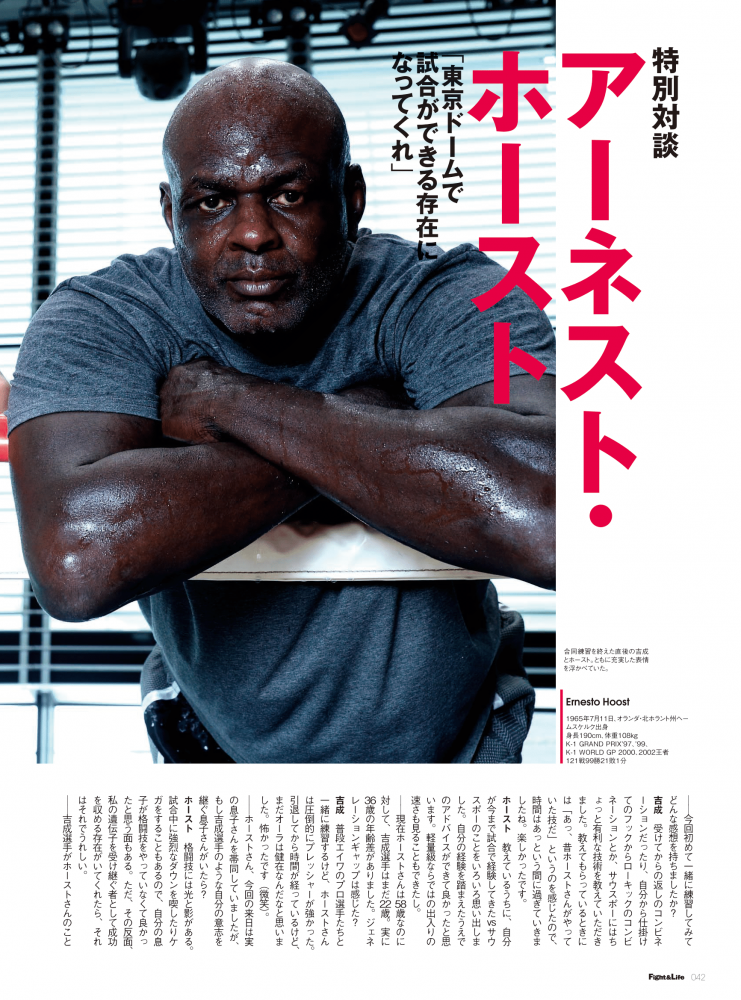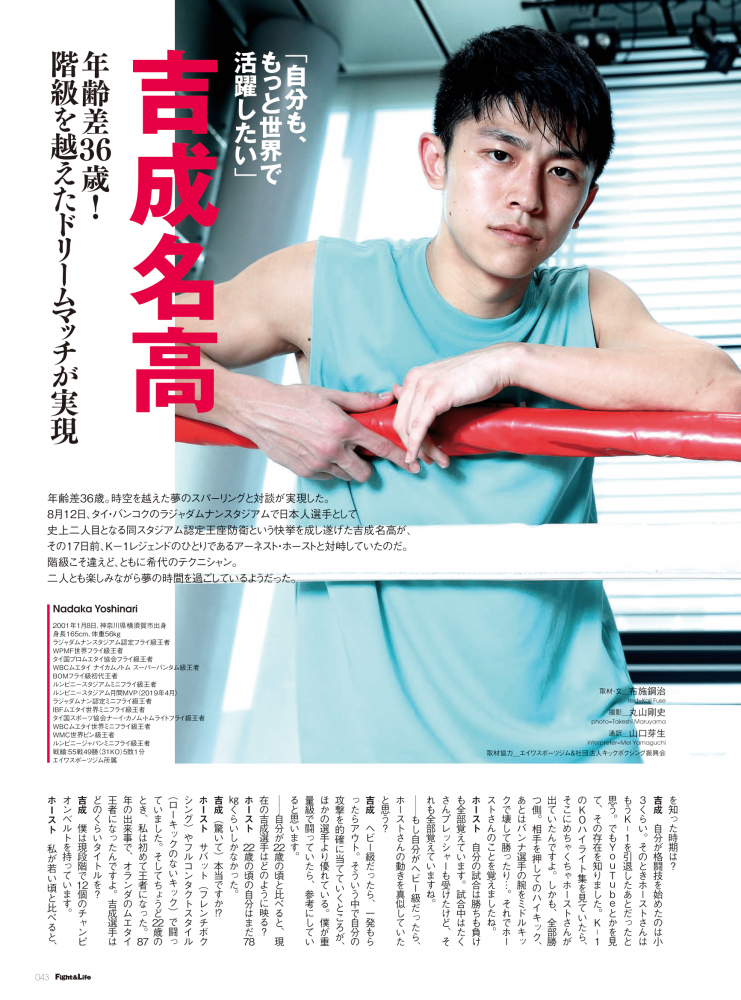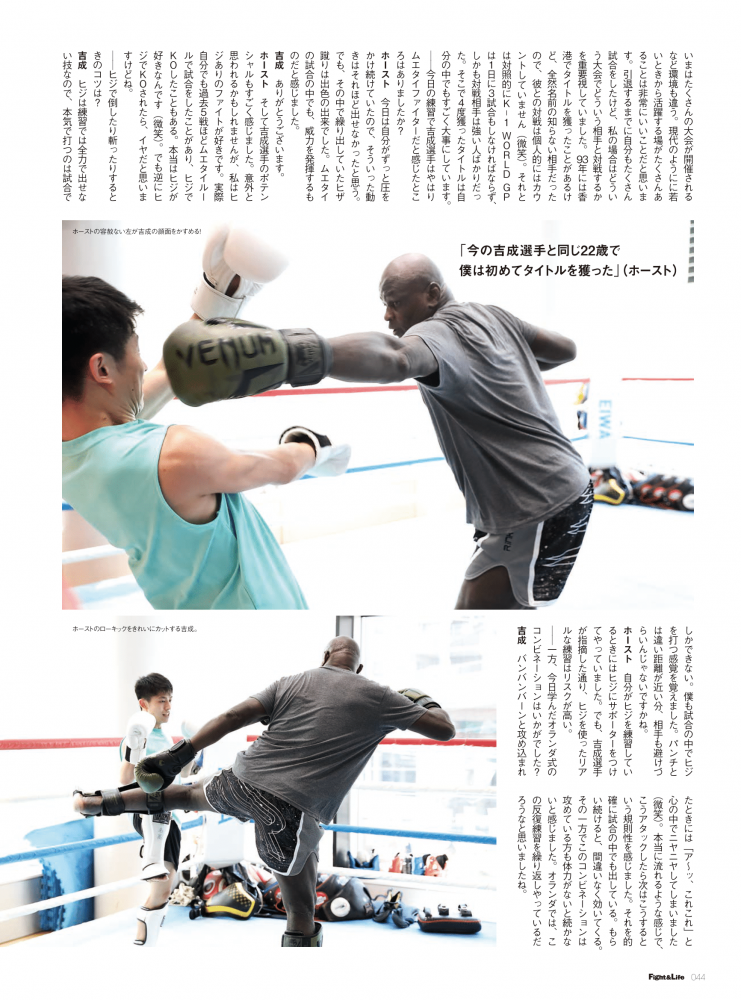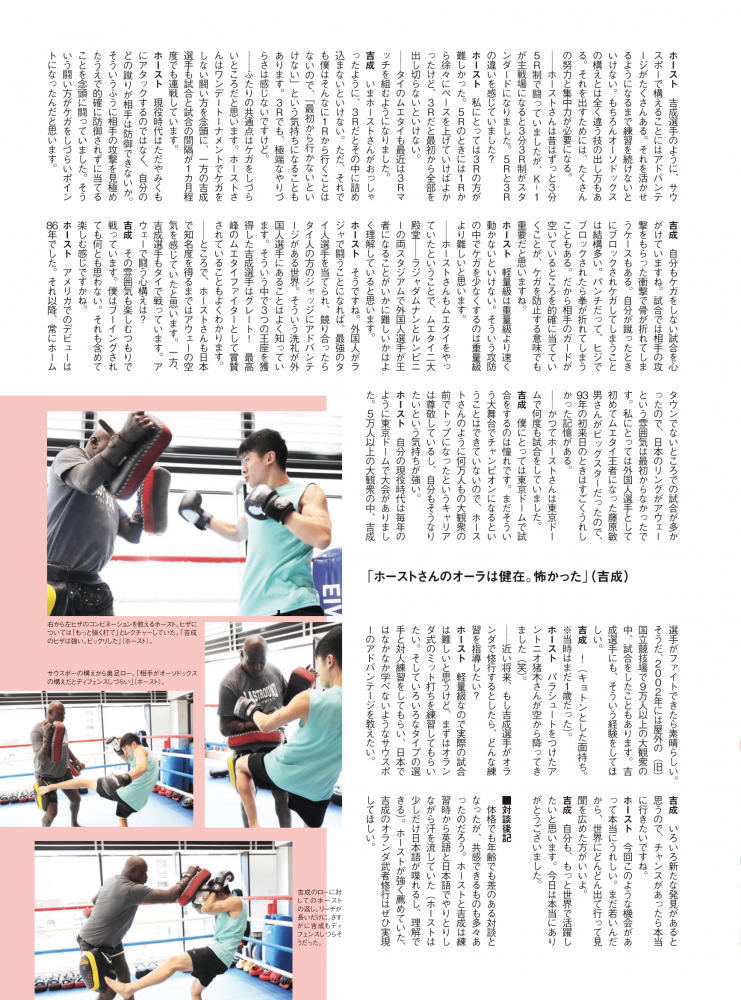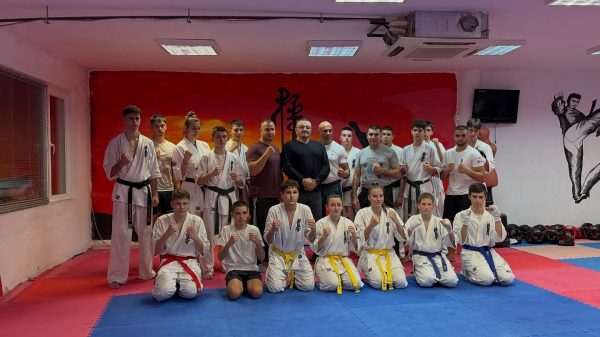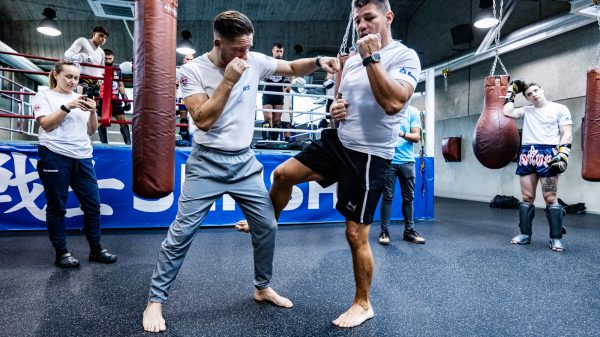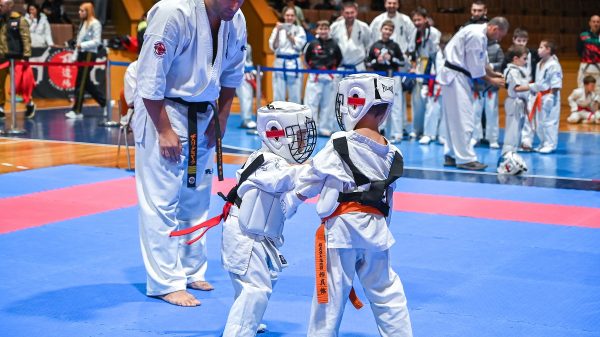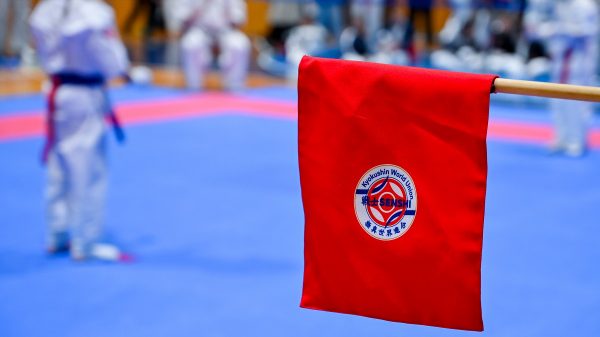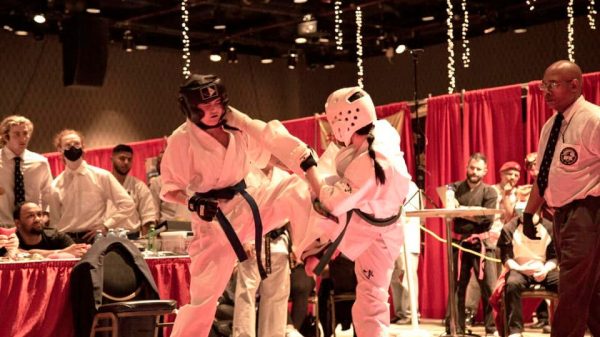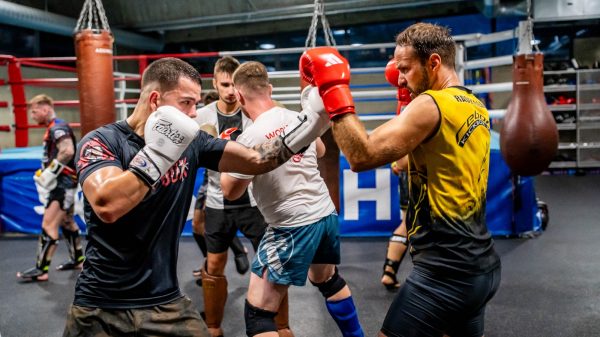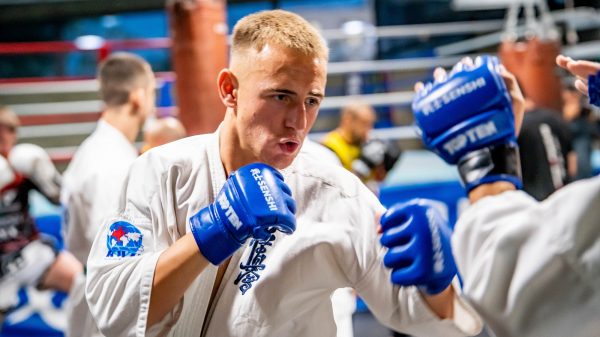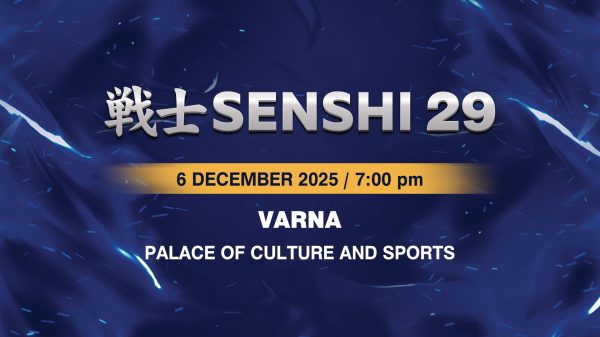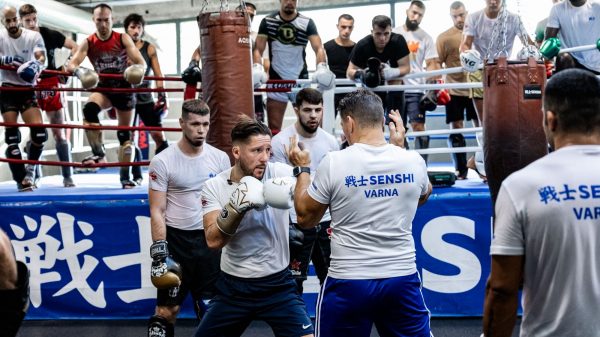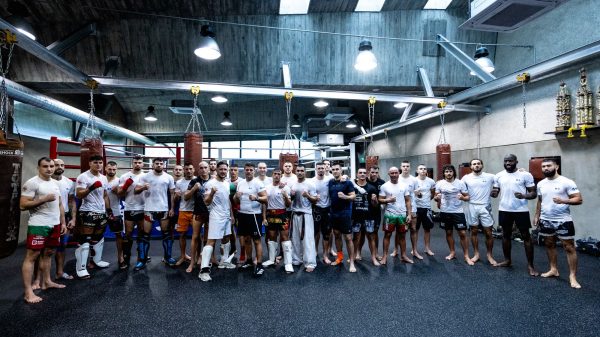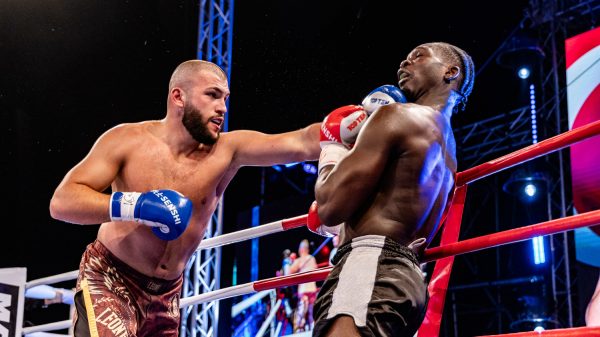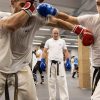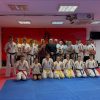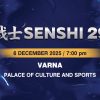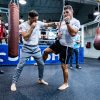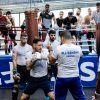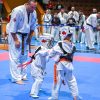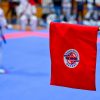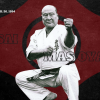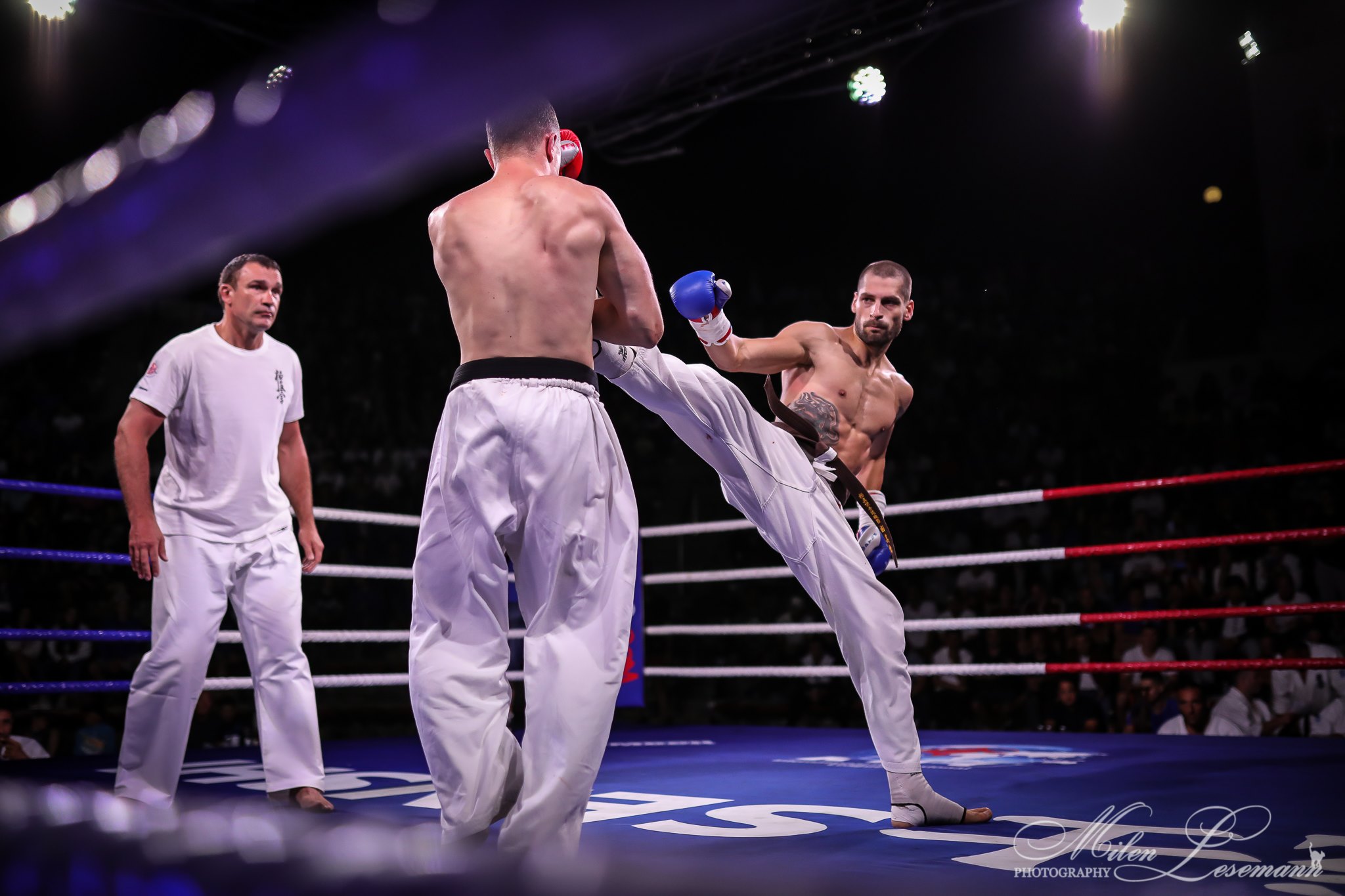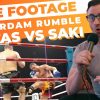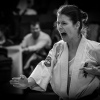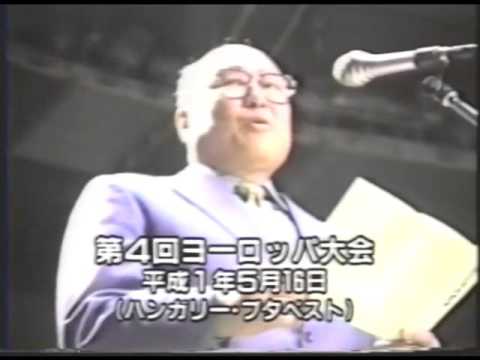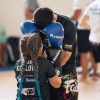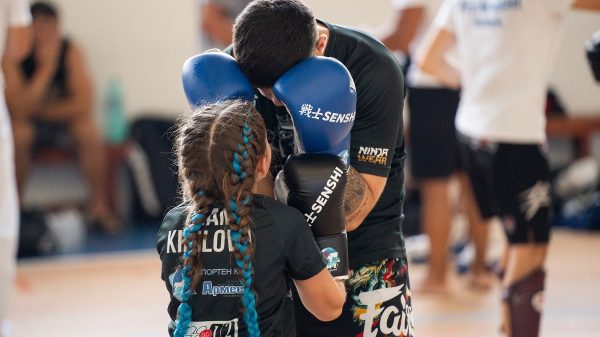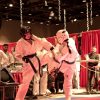Fight&Life – ファイト&ライフ magazine
Text: Koji Fuse
Photo: Takeshi Maruyama
Interpreter: Mei Yamaguchi
Coverage with the help of Eiwa Sports Gym and Kickboxing Promotion Association
Ernesto Hoost – “Become a fighter who can compete at Tokyo Dome!”
Nadaka Yoshinari – An age difference of 36 years! A dream match beyond weight classes has become a reality. “I also want to be more active on the world stage”
“This was your first practice together – what are your impressions?”
Yoshinari: Mr. Hoost taught me some techniques that are a little advantageous for a Southpaw fighter, such as counter combinations after receiving an attack or a hook-low kick combination initiated by me. As he explained to me, I thought, “Oh, this is a technique that he used to use,” and the time passed in the blink of an eye. I really enjoyed it!
Hoost: As I was teaching him, I recalled various experiences from my matches against Southpaw fighters up to now. I am glad that I could give advice based on my own experience. I was also able to see the speed unique to the lightweight division as he was getting in and out.
“Mr. Hoost is now 58 years old, and Yoshinari, you are still only 22. There is indeed an age difference of 36 years. Did you feel a generation gap?”
Yoshinari: I usually train together with EIWA’s pro players, but Mr. Hoost had an overwhelmingly strong presence. Even though time has passed since he retired, I thought his aura is very much alive. I was scared (laughs).
“Mr. Hoost, this time you have brought your own son with you here in Japan, but what if you had a son like Yoshinari who would follow your will and you in your footsteps?”
Hoost: There are both light and dark sides to martial arts. There are sometimes hard knockdowns or injuries during matches and in some respect, I am glad that my own son is not into combat sports. However, on the other hand, if I had someone successor carrying my genes who would achieve such success, this would make me happy.
“Yoshinari, when did you first hear about Ernesto Hoost?”
Yoshinari: I started practicing martial arts when I was in the 3rd grade of primary school. I think that at that time, Mr. Hoost had already retired from K-1. But I learned about him while watching YouTube. I was watching a K-1 KO Highlights video, and Mr. Hoost was constantly appearing in them. Furthermore, he was always on the winning side. Pushing his opponent, delivering a high kick, and winning by breaking Le Banner’s arm with a middle kick… That’s how I remembered him.
Hoost: I remember all of my matches – wins and losses alike. I felt great pressure during the fights and remember all those moments.
“If you were in the heavyweight division, do you think you would copy Mr. Hoost’s movements?”
Yoshinari: In heavyweight, you receive one blow and are out. In such circumstances, his ability to accurately land his attacks stands out as superior to other fighters. If I was fighting in the heavyweight division, I think I would have used it as a reference.
“Comparing today’s Yoshinari to yourself at the age of 22, how does he appear to you?”
Hoost: At the age of 22, I was still only 78 kg.
Yoshinari: (Surprised) Really?!
Hoost: I was fighting in savate (French boxing) and full contact style (without low kicks). It was exactly at the age of 22 that I first became a champion. It was in 1987. I became a Muay Thai champion of the Netherlands. Yoshinari, how many titles do you have?
Yoshinari: At present, I’m holding 12 champion belts.
Hoost: The environment is also different compared to what it was when I was young – there are many more tournaments nowadays. I think it is a great thing that there are so many opportunities for young people to show and perfect their skills from a young age. I had fought many matches before I retired, but in my case, I placed great importance on what type of tournament I would take part in and on what kind of an opponent I would be facing. I won a title in Hong Kong in 1993, but since the opponent’s name was completely unfamiliar to me, I personally don’t count that match (smiles). In contrast to that, at K-1 WORLD GP, I had to fight 3 matches a day, and besides that, all of my opponents were very strong fighters. So, the four titles I won there are very important to me.
“Was there something in today’s practice that made you feel that Yoshinari is essentially a Muay Thai fighter?”
Hoost: Today, I kept pressing him all the time, and I think that because of this, he could not show those moves as much. But the knee-kicks he kept delivering were outstanding. I felt them as something that can definitely demonstrate his power in a Muay Thai match.
Yoshinari: Thank you very much.
Hoost: I also felt Yoshinari’s potential. You might be surprised to hear this, but I actually like fights with elbows. In fact, I’ve got about 5 matches by the rules of Muay Thai in the past, and I’ve also knocked out an opponent using my elbow. I really love elbows (smiles). I definitely wouldn’t like to be knocked out by an elbow, though.
“Is there a “trick” when hitting or taking down an opponent with an elbow?”
Yoshinari: Elbow strikes are a technique that you cannot use with full force during practice, so delivering them with the full intent to strike is something you may do only in a real match. I also learned what it is to deliver elbow strikes in my matches. Unlike punches, the distance to your opponent is very close, but on the other hand, it is also difficult for them to avoid them.
Hoost: When practicing elbow strikes, I used to use elbow support. However, as Yoshinari pointed out, real practice holds a high risk.
“How were the Dutch-style combinations that you learned today?”
Yoshinari: When I was attacked with bang bang bang, I was first confused and startled, thinking, “Oh! I should do this and this…” (smiles). It was like a flow. I felt a kind of regularity – if I attack like this, then next I should do like that. He is doing this very precisely, even during his matches. If you keep receiving, the effect undoubtedly starts to appear. On the other hand, I felt that in this combination, the one attacking also cannot keep going if they don’t have sufficient stamina. I suppose that in the Netherlands, they’re doing such repetitive exercises over and over again.
Hoost: There are many advantages to fighting in a southpaw stance like Yoshinari. But in order to be able to make the most of it, one should continue practicing. Of course, there are techniques that are completely different from those in the orthodox stance. And using such techniques requires great effort and concentration.
“Mr. Hoost, in the past, you used to fight in 5-rounds-of-3-minute format, but K-1’s main completion standard became 3 3-minute rounds. Did you feel a difference between 3 rounds and 5 rounds?”
Hoost: For me, the 3-round format was more difficult. When you’ve got 5 rounds, you can gradually increase the pace from the first round on, but in a 3-round format, you have to give it your all right from the beginning.
“Thai muay thai has also recently started organizing 3-round matches”
Yoshinari: As Mr. Hoost has just pointed out, when it’s only 3 rounds, you have to jam-pack everything. But even so, I don’t throw myself right from the first round so often, so there are times when I feel I should go for it from the very start. However, even in 3 rounds, I don’t feel any extreme discomfort.
“It seems to me that a common point between you two is that you are both less prone to injuries. Mr. Hoost, you keep in mind a fighting style that helps you avoid injuries in one-day tournaments, while Yoshinari, you compete, leaving intervals of about one month between fights.”
Hoost: In my days as an active player, I was constantly trying to figure out which of my kicks my opponent would not be able to block and not just attack them blindly. I fought, always trying to read my opponent’s attacking move and land my strikes without being blocked. I think this style of fighting became a key factor in avoiding injuries.
Yoshinari: I’m also trying to keep my fight injury-free. It sometimes happens to break a bone as a result of the impact after receiving an attack. I very often get injured when my kicks are blocked. Even punches may result in a broken fist if blocked with an elbow. Therefore, aiming accurately at where your opponent’s guard is open is very important from the point of avoiding injuries.
Hoost: In the lightweight division, you have to move much faster than in heavyweight. Minimizing injuries in such offense-defense play is more difficult than in heavyweight.
“Mr. Hoost, you also did Muay Thai, and I think you very well understand what it is like for a foreigner to become a world champion at the two greatest halls of fame of Muay Thai – the Rajadamner Stadium and the Lumpinee Stadium.”
Hoost: Yes, indeed. When a foreigner competes at Rajadamnern, they are often faced with the strongest Thai fighters, and in such competitions, Thai fighters tend to have an advantage with the judges. I am well aware that foreign fighters very often undergo such baptism. To be able to win 3 championships in such circumstances – Yoshinari is great! It’s clear why he is praised as a top Muay Thai fighter.
“By the way, Mr. Hoost, I think you also experienced the air of being away from home until you gained recognition and popularity in Japan. Yoshinari, you also fight away – in Thailand. What is the mindset for competing as an “away” fighter?
Yoshinari: I fight with my mindset to enjoy even this atmosphere. Even if I‘m being booed, I don’t think anything of it. I guess I enjoy this as well.
Hoost: My debut in the USA was in 1986. Since then, I fought mostly away from my hometown, so from the first step in the ring in Japan, I didn’t have the feeling of being “away”. For me, Toshio Fujiwara, who was the first foreigner to become a Muay Thai champion, was a great star, and I remember that when I first visited Japan in 1993, I was actually very happy.
“Mr. Hoost, in the past, you played a lot of matches at the Tokyo Dome.”
Yoshinari: To fight at the Tokyo Dome is a dream. For me, it’s a dream to fight in the Tokyo Dome. I haven’t been able to become a champion on such a grand stage yet, so I do respect Horst’s career of reaching the top in front of tens of thousands of spectators as he did, and I have a strong desire to be able to do the same.
Hoost: During my active fighter career, I had a match at the Tokyo Dome almost every year. If Yoshinari could have a match in front of over 50 thousand spectators, it would be really great! Oh, yeah, in 2002, I did a match at the old National Stadium in front of 90 thousand people. I really hope that Yoshinari will one day have such an experience.
Yoshinari:! (Unbelieving expression on his face. ※ At that time, he was still 1 year old).
Hoost: Antonio Inoki came down from the sky with a parachute (laughs).
“If in the near future, Yoshinari could go to the Netherlands for training, what kind of practice would you like to teach him?”
Hoost: Since he is a lightweight fighter, a real match would probably be difficult to organize, but first of all, I’d like him to practice Dutch-style mitts. I’d also have him practice sparing sessions with different types of players, and I’d like to teach him some advantages unique to a southpaw stance which are difficult to learn in Japan.
Yoshinari: I’ll surely discover many new things, so if I have a chance, I’d really like to go.
Hoost: I am really happy for the opportunity I had this time. You are still young, and you should go out in the world more and more and broaden your horizons.
Yoshinari: I also want to be more active on the world stage. I really thank you very much for today!
Postscript to the conversation
Although there was a difference in age and physique, I think they resonated with each other on many points throughout the conversation. From the start of their practice, both Hoost and Yoshinari were talking in English and Japanese and sweating together (Ernesto Hoost speaks a little Japanese and understands). I really hope that Yoshinari’s fighter training in the Netherlands, which Hoost so strongly recommended, will come true.
Text: Koji Fuse
Photo: Takeshi Maruyama
Interpreter: Mei Yamaguchi
